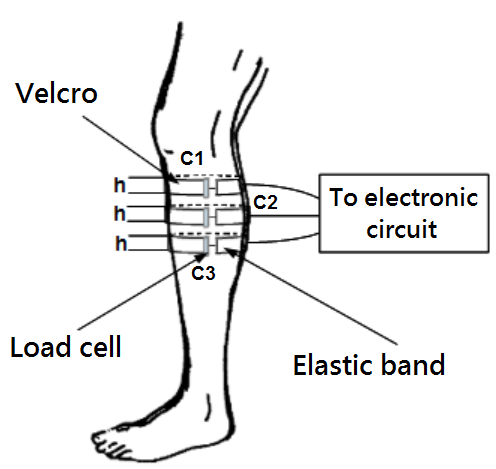A Novel Stretch Sensor to Measure Venous Hemodynamics
Keywords:
stretch sensor, venous hemodynamic, plethysmography, venous duplexAbstract
Chronic venous insufficiency is a debilitating condition causing varicose veins and venous ulcers. The pathophysiology includes reflux and venous obstruction. The diagnosis is often made by clinical examination and confirmed by Venous Doppler studies. Plethysmography helps to quantitatively examine the reflux and diagnose the burden of deep venous pathology to better understand venous hemodynamics, which is not elicited by venous duplex examination alone. However, most of these tests are qualitative, expensive, and not easily available. In this paper, we demonstrate the potential use of a novel stretch sensor in the assessment of venous hemodynamics during different maneuvers by measuring the change in calf circumference. We designed the stretch sensor by using semiconductor strain gauges pasted onto a small metal bar to form a load cell. The elastic and Velcro material attached to the load cell form a belt. It converts the change in limb circumference to a proportional tension (force of distension) when placed around the calf muscle. We recorded the change in limb circumference from arrays of stretch sensors by using an in-house data acquisition system. We calculated the venous volume (VV), venous filling index (VFI), ejection fraction (EF) and residual venous volume (RVV) on two normal subjects and on two patients to assess venous hemodynamics. The values (VV > 60 ml, VFI < 2ml/s, EF > 60%, RVV < 35%) in normal subjects and (VV < 60 ml, VFI > 2ml/s, EF < 60%, RVV > 35%) in patients were comparable to those reported in the literature.
References
R. A. Oliveira, N. Barros Jr., and F. Miranda Jr., “Variability of venous hemodynamics detected by air plethysmography in CEAP clinical classes,” Jornal Vascular Brasileiro, vol. 6, no. 4, pp. 359-365, December 2007.
C. Wittens, A. H. Davies, N. Bækgaard, et al., “Editor’s choice - management of chronic venous disease: clinical practice guidelines of the european society for vascular surgery (ESVS),” European Journal of Vascular and Endovascular Surgeryg, vol. 49, no. 6, pp. 678-737, June 2015.
V. Ibegbuna, K. T. Delis, and A. N. Nicolaides, “Haemodynamic and clinical impact of superficial, deep and perforator vein incompetence,” European Journal of Vascular and Endovascular Surgeryg, vol. 31, no. 5, pp. 535-541, May 2006.
A. N. Nicolaides and D. S. Sumner, Investigations of patients with deep vein thrombosis and chronic venous insufficiency, LA: Med-Orion Publishing, January1991.
B. O’Brien, T. Gisby, and I. Anderson, “Stretch sensors for human body motion,” Proc. SPIE, vol. 9056, pp. 905618-1-905618-9, 2014.
S. Raju, “New aproaches to the diagnosis and treatment of venous obstruction,” Journal of vascular surgery, vol. 4, no. 1, pp. 42-54, July 1986.
E. Criado, M. A. Farber, W. A. Marston, et al., “The role of air plethysmography in the diagnosis of chronic venous insufficiency,” Journal of vascular surgery, vol. 27, no. 4, pp. 660-670, April 1998.
B. B. Lee, A. N. Nicolaides, K. Myers, et al., “Venous hemodynamic changes in lower limb venous disease: the UIP consensus according to scientific evidence,” International Angiology, vol. 35, no. 3, pp. 236-352, June 2016.
S. Wankhar, A. A. Kota, and D. Selvaraj, “A versatile stretch sensor for measuring physiological movement using a centre loaded, end supported load cell,” Journal of Medical Engineering and Technology, vol. 41, no. 5, July 2017.
J. J. Bergan and N. Bunke-Paquette, The vein book, 2nd ed., USA: Oxford university press, 2014.
M. L. Katz, A. J. Comerota, and R. Kerr, “Air Plethysmography (APG): A new technique to evaluate patients with chronic venous insufficiency,” The Journal of Vascular Technology, vol. 15, pp. 23-27, 1991.
M. H. Meissner, “Lower extremity venous anatomy,” Seminars in Interventional Radiology, vol. 22, no. 3, pp. 147-156, 2005.

Published
How to Cite
Issue
Section
License
Submission of a manuscript implies: that the work described has not been published before that it is not under consideration for publication elsewhere; that if and when the manuscript is accepted for publication. Authors can retain copyright in their articles with no restrictions. is accepted for publication. Authors can retain copyright of their article with no restrictions.
Since Jan. 01, 2019, AITI will publish new articles with Creative Commons Attribution Non-Commercial License, under The Creative Commons Attribution Non-Commercial 4.0 International (CC BY-NC 4.0) License.
The Creative Commons Attribution Non-Commercial (CC-BY-NC) License permits use, distribution and reproduction in any medium, provided the original work is properly cited and is not used for commercial purposes.



